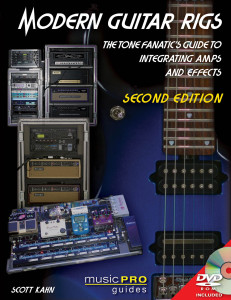Scott Kahn talks about the 2nd edition of his book “Modern Guitar Rigs: The Tone Fanatics Guide to Integrating Amps and Effects”
Scott Kahn is Editor in Chief & Founder of the online magazine MusicPlayers.com and author of the book “Modern Guitar Rigs: The Tone Fanatic’s Guide to Integrating Amps & Effects, 2nd Edition”.
Scott, you have written hundreds of pages about modern guitar rigs and rack gear. What are the benefits of a rack mounted guitar rig compared to pedalboards? Why should one build a guitar rack?
Every pro has at least some of their rig housed in racks. Rack setups facilitate easy setup/teardown and much less wear and tear on your gear. Even if you’re a pedal guy… stash your pedals in a tray in a rack and they will last decades in great condition. The constant plugging/unplugging of cables really takes a toll on equipment. I have a “complex” rig with a tube amp half stack, rack gear, pedals on a shelf, switching system, MIDI foot controller… the whole right can be set up in less than three minutes. If I stuck my actual amp head in the rack case, setup would be reduced to 30 seconds.
Another key consideration is power. In the typical club scenario, your pedalboard gets plugged into a different circuit than your amp on the back line, which can result in unwanted noise in your rig, and if one or the other isn’t properly grounded, you can really hurt yourself, too. And with a bunch of pedals, if you care about great tone, you probably want some of those pedals in front of your amp and some of them in your effects loop, so you’ve got to run four long cables from your amp to your board — try not to trip on those, and make sure they are well insulated noise-wise.
Finally, if you love pedals, using audio looping products can help you end the famous “pedal tap dance” where you try to switch effects on 2-3 pedals instantaneously while playing. A little planning lets you build a modern guitar rig where a single button press on a foot controller changes all of your pedals on/off status while rest out of harms way in a rack, or even on a pedalboard.
Why did you decide to write a book about all the gear that comprises a guitar rack?
Players get all sorts of advice about the various components of their guitar rig from online forums: questions about audio loopers, amp switching systems, foot controllers, running wet/dry rigs, etc… but there’s no guidance as to where and how each of these tools fits into your guitar rig. So people buy one thing trying to solve a problem, only to find out that something else needs to be addressed before what they just bought will work properly in their rig. Players need a template or road map that guides them through all of the components of what makes a real “guitar rig” and they need to understand how the various pieces make a difference in their sound.
Tell us a little bit about the content of the book. What are you talking about?
I build the rig from the ground up, starting by looking at your effects loop and the importance of determining what items run best into the front of your amp vs. in the loop. From there, we look at how to switch between a few amps, how to incorporate rack-based effects, how to put your pedals under remote control, and then move on to talking about all the gear that pros use in their guitar rigs to address everything from running wireless systems to proper power conditioning to ordering custom rack cases. I also explore in-depth some great rigs from pros like John Petrucci and Steven Wilson, and I interviewed many of the best pro rig builders to get some insights as to what’s happening with players and their rigs in general.
Any other hints for people considering building a modern guitar rig?
Build the rig that is right for your sound and your style of playing — not the rig that some guy online recommends who has no idea what it’s like to play in your jazz fusion-meets-polka-with-a-twist-of-metal band. Just because a guy sing the praises of a wet/dry rig doesn’t mean that it’s right for your guitar rig. And don’t be afraid of complexity or cost: both of those aren’t nearly as bad as you might think once you take a logical approach to learning how the various components work together to form a rig.
What do you think are the future trends?
Well, today, pedals are back in huge popularity. But for anyone who loves playing with effects, eventually you’ll grow tired of stepping on each of your 20 pedals one at a time and realize that a more integrated approach can result in happier playing. Rack gear has been experiencing a surge of new popularity, especially since MIDI foot controller technology has gotten so much easier to use with the advent of computer-based software editors. Instead of having to deal with cryptic, two-line numeric displays, you now have super-simple drag-and-drop simplicity of configuring your sounds.







